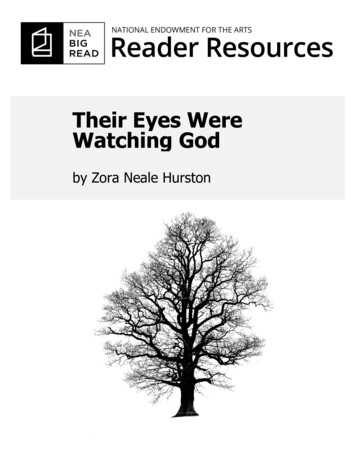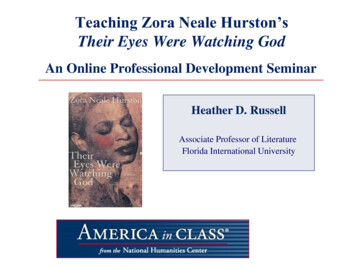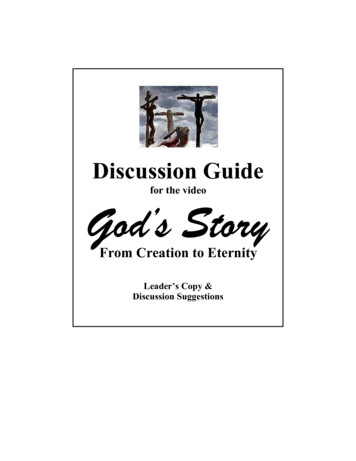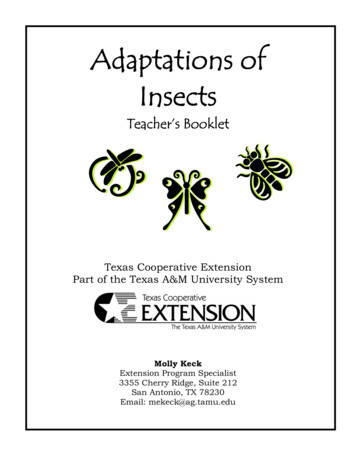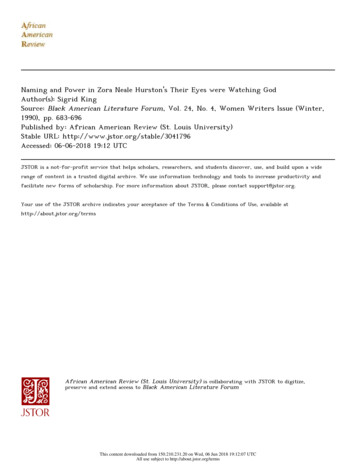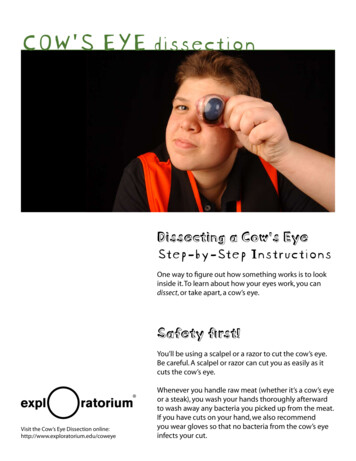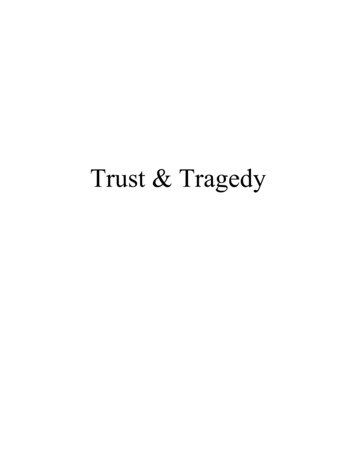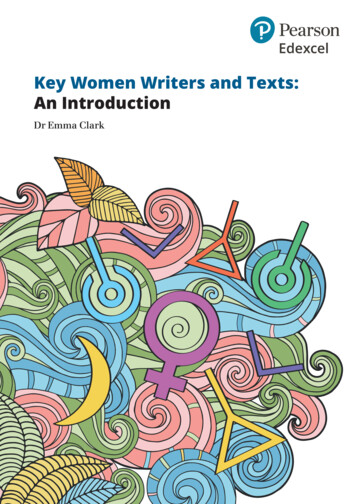
Transcription
ZORA NEALE HURSTONTheirEyes WereWatching GodWith a Foreword by Edwidge Danticat
To Henry Allen Moe
ContentsE-Book ExtraJanie’s Great Journey: A Reading GroupGuideAcknowledgmentsForeword by Edwidge DanticatForeword by Mary Helen Washington1 Ships at a distance have every man’s wishon board.2 Janie saw her life like a great tree inleaf 3 There are years that ask questions andyears that answer.4 Long before the year was up, Janie
noticed that her 5 On the train the next day, Joe didn’tmake many 6 Every morning the world flung itself overand exposed the 7 The years took all the fight out of Janie’sface.8 After that night Jody moved his thingsand slept in 9 Joe’s funeral was the finest thing OrangeCounty had ever 10 One day Hezekiah asked off from workto go off 11 Janie wanted to ask Hezekiah about TeaCake, but she 12 It was after the picnic that the town
began to 13 Jacksonville. Tea Cake’s letter had saidJacksonville. He had worked 14 To Janie’s strange eyes, everything inthe Everglades was big 15 Janie learned what it felt like to bejealous. A 16 The season closed and people went awaylike they had 17 A great deal of the old crowd were back.But 18 Since Tea Cake and Janie had friendedwith the Bahaman 19 And then again Him-with-the-squaretoes had gone 20 Because they really loved Janie just a
little less than Afterword by Henry Louis Gates, Jr.About the AuthorBooks by Zora Neale HurstonCreditsCopyrightAbout the Publisher
E-Book ExtraJanie’s Great Journey:A Reading Group GuideTheir Eyes Were Watching Godby Zora Neale HurstonIntroductionIn her award-winning autobiography, Dust Tracks ona Road(1942), Zora Neale Hurston claimed to havebeen born in Eatonville, Florida, in 1901. She was, infact, born in Notasulga, Alabama, on January 7,1891, the fifth child of John Hurston (farmer,carpenter, and Baptist preacher) and Lucy Ann Potts(school teacher). The author of numerous books,including Their Eyes Were Watching God , Jonah’sGourd Vine, Mules and Men, and Moses, Man ofthe Mountain, Hurston had achieved fame andsparked controversy as a novelist, anthropologist,outspoken essayist, lecturer, and theatrical producerduring her sixty-nine years. Hurston’s finest work offiction appeared at a time when artistic and political
statements—whether single sentences or book-lengthfictions—were peculiarly conflated. Many works offiction were informed by purely political motives;political pronouncements frequently appeared inpolished literary prose. And Hurston’s own politicalstatements, relating to racial issues or addressingnational politics, did not ingratiate her with her blackmale contemporaries. The end result was that TheirEyes Were Watching God went out of print not longafter its first appearance and remained out of print fornearly thirty years. Henry Louis Gates, Jr., has beenone among many to ask: “How could the recipient oftwo Guggenheims and the author of four novels, adozen short stories, two musicals, two books onblack mythology, dozens of essays, and aprizewinning autobiography virtually ‘disappear’ fromher readership for three full decades?”That question remains unanswered. The factremains that every one of Hurston’s books wentquickly out of print; and it was only through thedetermined efforts, in the 1970s, of Alice Walker,Robert Hemenway (Hurston’s biographer), ToniCade Bambara, and other writers and scholars thatall of her books are now back in print and that shehas taken her rightful place in the pantheon ofAmerican authors.In 1973, Walker, distressed that Hurston’s
writings had been all but forgotten, found Hurston’sgrave in the Garden of Heavenly Rest and installed agravemarker. “After loving and teaching her work fora number of years,” Walker later reported, “I couldnot bear that she did not have a known grave.” Thegravemarker now bears the words that Walker hadinscribed there:ZORA NEALE HURSTONGENIUS OF THE SOUTHNOVELIST FOLKLORIST ANTHROPOLOGIST(1891-1960)Questions for Discussion1. What kind of God are the eyes ofHurston’s characters watching?What is the nature of that God andof their watching? Do any of themquestion God?2. What is the importance of the conceptof horizon? How do Janie and eachof her men widen her horizons?
What is the significance of thenovel’s final sentences in thisregard?3. How does Janie’s journey—fromWest Florida, to Eatonville, to theEverglades—represent her, and thenovel’s increasing immersion inblack culture and traditions? Whatelements of individual action andcommunal life characterize thatimmersion?4. To what extent does Janie acquire herown voice and the ability to shapeher own life? How are the tworelated? Does Janie’s telling herstory to Pheoby in flashbackundermine her ability to tell herstory directly in her own voice?5. What are the differences between thelanguage of the men and that ofJanie and the other women? Howdo the differences in languagereflect the two groups’ approachesto life, power, relationships, andself-realization? How do thenovel’s first two paragraphs pointto these differences?
6. In what ways does Janie conform toor diverge from the assumptionsthat underlie the men’s attitudestoward women? How would youexplain Hurston’s depiction ofviolence toward women? Does thenovel substantiate Janie’s statementthat “Sometimes God gits familiarwid us womenfolks too and talksHis inside business”?7. What is the importance in the novel ofthe “signifyin’” and “playin’ dedozens” on the front porch of Joe’sstore and elsewhere? Whatpurpose do these stories, tradedinsults, exaggerations, and boastshave in the lives of these people?How does Janie counter them withher conjuring?8. Why is adherence to received traditionso important to nearly all the peoplein Janie’s world? How does thecommunity deal with those who are“different”?9. After Joe Starks’s funeral, Janierealizes that “She had been getting
ready for her great journey to thehorizons in search of people; it wasimportant to all the world that sheshould find them and they find her.”Why is this important “to all theworld”? In what ways does Janie’sself-awareness depend on herincreased awareness of others?10. How important is Hurston’s use ofvernacular dialect to ourunderstanding of Janie and theother characters and their way oflife? What do speech patternsreveal about the quality of theselives and the nature of thesecommunities? In what ways are“their tongues cocked and loaded,the only real weapon” of thesepeople?
AcknowledgmentsThe Estate of Zora Neale Hurston would like tothank those people who have worked so hard overthe years in introducing new generations of readers tothe work of Zora Neale Hurston. We are indebted toRobert Hemenway, Alice Walker, and all theModern Language Association folks who helpedusher in Zora’s rediscovery. We are also deeplyappreciative of the hard work and support of ourpublisher, Cathy Hemming; our editor, JuliaSerebrinsky; and our agent, Victoria Sanders, withoutwhom this reissue would not have been possible.
ForewordBY EDWIDGE DANTICATI“Ships at a distance have every man’s wish onboard.” So begins Zora Neale Hurston’s brilliantnovel about a woman’s search for her authentic selfand for real love. At first it might seem contradictorythat a work whose central character is the remarkablyresolute and resilient Janie Crawford should start witha dictum about “the life of men.” However, that is oneof the many shrewd manifestations of Zora NealeHurston’s enormous talents: her ability to render aworld complete with its codes and disciplines within afew sentences, and then placing in that world hervision of how her people—the women and men ofher own creation, her characters—function, triumph,and survive. So off that metaphorically distant shipcomes our heroine Janie Crawford, and suddenly werealize that she had been on her own singular journeyall along, her dreams “mocked to death by Time,” butnever totally defeated. And since women “remembereverything they don’t want to forget,” Janie Crawfordrecalls all the crucial moments of her life, from thetime she first discovers that she is a “colored” little girl
by searching for her face in a group photograph, tothe moment she returns to Eatonville, Florida, fromthe Everglades, not swindled and deceived, as hadbeen expected, but heartbroken, yet boldly defiant,after having toiled in the bean fields, survived ahurricane, and lost the man she loved.Janie Crawford is able to retrace her steps,disembark from her own ship, come home, andremember, because she has been close to death buthas lived a very full life. So in spite of the judgmentalvoices that greet her upon her return, in spite of the“mass cruelty” invoked by her prodigal status, Janiehas earned the right to be the griot of her own tale,the heroine of her own quest, the “member” of herown remembering.In the loose call-and-response structure thatframes the novel—Janie’s friend Pheoby asks her totell her where she has been, and Janie responds withthe story that constitutes the book—Janie’s is anintimate audience of one. She entrusts her adventuresto Pheoby to retell to others only if Pheoby chooses.(“You can tell ’em what Ah say if you wants to. Dat’sjust de same as me ’cause mah tongue is in mahfriend’s mouf.”) Janie is recounting her story as muchto Pheoby as to herself. Her response to Pheoby’scall is at the same time an echo, much like the nymphEcho who retains only her voice after having literally
been torn apart. Hurston herself also becomes Janie’secho by picking up the narrative thread in intervals,places where in real life, or in real time, Janie mighthave simply grown tired of talking. Much like theporch sitters at the beginning of the book who are thefirst to see Janie arrive, Janie, Pheoby, and ZoraNeale Hurston form their own storytelling chain, andit is through their linking of voices that we are takenon this intimate yet communal journey that is TheirEyes Were Watching God.III have always been extremely proud to remind allwho would listen that Zora Neale Hurston’smasterpiece, Their Eyes Were Watching God, waswritten, by her own account, in seven weeks, in myhomeland, Haiti. I once made a complete fool ofmyself in front of a group of young women writerswho had just created a book club and had gracefullyinvited me to their first meeting. Soon after the bookclub’s newly elected president announced that thefirst book they’d be reading would be Their EyesWere Watching God, I intervened to declare, “Didyou know that Zora wrote it in seven weeks in Haiti?”I was hastily rebuffed by a curt “So?” from oneof the members.
“So?” I replied, embarrassed. “Could you writea book like that in seven weeks?”Of course Hurston’s own account of how long ittook to compose the novel has been debated andcontested. However, I am awed by her ability to havefound the time during her anthropological travels andconstant research in Haiti to produce a novel—at all.As a writer, I am amazed by the way she oftenmanaged to use the places and circumstances shefound herself in to create a room, a world, of herown. Even with the menace of pennilessness alwayslooming, she somehow unearthed the solace, orperhaps the desperation, to write.Many of my contemporaries, including myself,often complain—sometimes with book contracts intow—about not having enough time, money, andspace to write. Yet Zora battled to write and she did,knowing, as Janie Crawford must have also known,that “there is no agony like bearing an untold storyinside you.” Thus, no matter how many times I haveread this book, when Janie begins telling that untoldstory inside her, I am always doubly elated, both withthe story itself and with the way in which it came tobe. And so when I blurt out my favorite piece ofHurston trivia, I do it partially out of pride for herassociation with Haiti, but I also do it heeding AliceWalker’s extremely wise advice in her foreword to
Robert E. Hemenway’s literary biography of Hurston:“We are a People.” (And I include all theinternational peoples of the African diaspora in thiscategory.) “A People do not throw their geniusesaway.”Fortunately, over the years, I have met very fewactive readers of my generation (born after 1960),writers and nonwriters alike, who would evenconsider throwing Zora away. Many of us canremember vividly our first encounter with her work,particularly Their Eyes Were Watching God.Because of the efforts of Ms. Walker and others,who valiantly reclaimed Zora for themselves and forall of us, we read Zora either in high school or incollege classes, where her work is enthusiasticallytaught by men and women—most of whom weremuch older than we were when they first read her—and still had the exuberance of a recent discovery,much as in the early days of a love affair, or a reunionwith a friend long thought dead.I first read Their Eyes Were Watching God inan elective black history class at Clara Barton HighSchool in Brooklyn, New York. The class was taughtby a young teacher who conducted it during his lunchhour. There was not much reading for young adultsabout Zora and her work, so we struggled with theplot and the language with a lot of coaching from our
teacher. Most of us were new immigrants to theUnited States and read Janie, Pheoby, and TeaCake’s dialogue out loud with our heavy Creoleaccents, and managed to come away with only aglimmer of the brilliance of what we had read.At times, feeling as if my lack of English hadrobbed me of precious narrative information, I wouldraise questions that went beyond the scope of thenovel, and my teacher would become very excited,applauding the fact that I was stretching myimagination way beyond the words in front of me,which is what all good readers are supposed to do.“Where was Tea Cake’s family?” I would ask. “Andwhat did Janie’s friend Pheoby do while Janie wasgone?”I would later explore more purposefullydeliberate questions about the book in a freshmanEnglish class at Barnard College, where Zora hadalso been a student in the 1920s. Hers were amongthe books in a glass case in the Barnard library thatalso highlighted other famous alumnae authors,including the poet, playwright, and novelist NtozakeShange. Each time I walked by that glass case, I feltmy dream of becoming an author growing more andmore attainable, partly because Zora and Ntozakewere black women, like me.“Zora has lived in my country,” I happily told
one of my classmates, “and now I am living in hers.” Iliked to think that Zora was drawn to Haiti partlybecause of the many similarities between Haitian andSouthern African-American culture. Zora was froman all-black town, run and governed by black people,and I was from a black republic, where FrederickDouglass had resided and where Katherine Dunhamhad studied and danced. In Tell My Horse, Zorafinds an equivalent for the cunning Brer Rabbit of theUncle Remus stories in Haiti’s sly Ti Malis of popularlore. And in the rural belief that our dead will one dayreturn to Ginen, Africa, she uncovered echoes of thestrong convictions of many of those who were forcedon board slave ships for points of no return.There were so many things that I found familiarin Their Eyes Were Watching God: the dead-onorality in both the narration and dialogue; thecommunal gatherings on open porches at dusk; theintimate storytelling (krik? krak!); the communal talltale sessions, both about real people who have erred(zen) and fictional folks who have hilariouslyblundered (blag). Her description of the elaborateburial of Janie’s pet mule reminded me of an incidentthat she detailed in Tell My Horse, in which Haitianpresident Antoine Simon ordered an elaborateCatholic funeral at the national cathedral for his petgoat Simalo, something many Haitians would laughabout for years.
In class at Barnard, we gladly raised structuralquestions about Their Eyes Were Watching God.Was it a love story or an adventure story? Wedecided it could be both, as many other complexnovels are. Besides, don’t adventures often includeromance? And aren’t all exciting romancesadventures?We brought up issues that concerned us asyoung feminists and womanists. Was Janie Crawforda good female role model or was she solely definedby the men in her life? Many of us argued that Janiedid not have to be a role model at all. She simply hadto be a fully realized and complex character, whichshe was. She certainly manifested a will of her own inspite of the efforts of her grandmother and her twofirst husbands to dominate her, leaving her firsthusband when life with him grew unbearable, andtaking off with Tea Cake against public opinion afterthe second husband died.Why did Janie allow Tea Cake to beat her?Some of us thought that Hurston tried to envisioncharacters who are neither too holy nor too evil. Hermen and women are extremely nuanced, reflectinghuman strengths as well as frailties. If Tea Cake weretoo cruel, then Janie would not love him at all. If hewere too uniformly pious, then rather than being herequal, as he was at work in the fields, he would be
worshipped by her, and “all gods who receivehomage are cruel. All gods dispense suffering withoutreasons half gods are worshipped in wine andflowers. Real gods require blood.” In the end, Janiereceives from Tea Cake the equivalent of all three—wine, flowers, and blood—and she becomes like atreasured relative whose love affair we could neverwholeheartedly condone, but the source of which wecould certainly understand. Tea Cake gives his life forJanie, and this, if nothing else, serves as someatonement for many of his sins.In spite of Janie’s choices concerning Tea Cake,or perhaps because of them, she experiences morefreedom than most women (certainly most poorwomen) of her time. And as much as she loves TeaCake, she ultimately chooses to live and not to diewith him, and her final act is not to follow him to thegrave, but to bury him and return alone to acommunity that will not embrace and welcome herwithout first being given an explanation as to whereshe has been and what she has been through.IIIFor many decades and, hopefully, centuries to come,Their Eyes Were Watching God will probably be atthe center of Zora Neale Hurston’s legacy as anovelist. Perhaps because it was written in such a
short and, reportedly, emotionally charged period,this is a novel with an overpowering sense of exigencyand urgency in its layered plot, swift pace, intricatenarration, and in the raw anguish evoked by theconflicting paths laid out for Janie Crawford as sheattempts to survive her grandmother’s restrictedvision of a black woman’s life and realize her ownself-conceived liberation. Like all individual thinkers,Janie Crawford pays the price of exclusion fornonconformity, much like Hurston herself, who wasaccused of stereotyping the people she loved whenshe perhaps simply listened to them much moreclosely than others, and sought to reclaim andreclassify their voices.The novel not only offers a penetrating view ofJanie’s evolving thinking process, but we are alsogiven plenty of insight into the mindsets of those whowould wish to condemn her. Janie, however, is neveroverly critical of her neighbors’ faultfinding reactionsto her. She either ignores them entirely or pities themfor never having left the safety of their town and neverhaving lived and loved as deeply as she has.Having survived all she has, Janie now has adeeper understanding of her own actions as well as agreater comprehension of human behavior in general.“It’s uh known fact, Pheoby, you got tuh gothere tuh know there,” she explains to her friend.
“Two things everybody’s got tuh do fuh theyselves They got tuh go tuh God and they got tuh find outabout livin’ fuh theyselves.”Along with the classic conflict between anindividual’s wishes and a community’s censure, thereare many contemporary motifs in this novel, eventsthat could have been easily plucked out of earlytwenty-first-century headlines: loveless marriages;verbal and physical abuse; mercy killing, or a killing inself-defense, depending on how you interpret it;forbidden love; a public and passionate affairbetween a younger man and an older woman fromdifferent stations in life. Many of the minor charactersin the novel are vibrantly multicultural, from AfricanAmericans to Native Americans to the Caribbeanswho live and work in the Everglades. (To this day,migrant labor and hurricanes remain very concreteelements of life in Florida.)The influence of Zora’s work, particularly TheirEyes Were Watching God, will continue to be feltfor years in the works of many generations of writers.For example, Janie Crawford shares a literary kinshipwith Celie of Alice Walker’s The Color Purple,whose eyes not only watch God, but whose wordsand letters, whose voice, speak directly to God.Part of the reason Janie’s grandmother Nanny
pushes her into a loveless marriage to Logan Killicks,her first husband, is that Nanny was born in slaveryand had little choice over her own destiny. Nanny hascraved small comforts, like sitting idly on a porch, andwants her granddaughter to have them, along withmoney and status, no matter what the emotional cost.What Nanny may not have considered is that Janiewould have her own ideas of freedom. However,Nanny is also pained by a deferred dream of herown.Nanny confesses to young Janie, “Ah wanted topreach a great sermon about colored women sittin’on high, but they wasn’t no pulpit for me.”In Toni Morrison’s Beloved, Beloved’sgrandmother Baby Suggs preaches the sermonNanny never got to preach. Baby Suggs “became anunchurched preacher, one who visited pulpits.”However, her most-used pulpit was one that BabySuggs created for herself, outdoors, in a clearing:“After situating herself on a huge flat-sided rock,Baby Suggs bowed her head and prayed silently .Finally she called the women to her. ‘Cry,’ she toldthem. ‘For the living and for the dead. Just cry.’ Andwithout covering their eyes the women let loose.”What a difference it might have made to youngJanie to have heard her grandmother preach thatsermon, to have heard her Nanny say, as Baby Suggs
did, “More than your life-holding womb and your lifegiving private parts love your heart. For this is theprize.”IVIn the circular narration of Their Eyes WereWatching God, at the end of the book, a whole newlife lies ahead, uncharted for a still relatively youngJanie Crawford. She has told her story and hassatisfied “that oldest human longing—self-revelation.”And now she must go on.We know that Janie will never forget Tea Cake.Not only did she love him very deeply, but her lifeand travels with him have opened up her world andher heart in irreversible ways. However, we get hintsthat Janie will continue to live on her ownuncompromising terms, for even as she has lost herbeloved, she has also discovered many deeper layersof herself.“Now, dat’s how everything wuz, Pheoby, jus’lak Ah told yuh,” she says to her friend as sheprepares to wrap up her story. “So Ah’m back homeagin and Ah’m satisfied tuh be heah. Ah done been tode horizon and back and now Ah kin set heah in mahhouse and live by comparisons.”
Janie’s life, by comparison, might seem moreturbulent than most. However, both her past and herfuture can best be characterized by the way shedescribes her love for Tea Cake at the end of thebook. Not like a “grindstone” that is the sameeverywhere and has the same effect on everything ittouches, but like the sea, the sea of distant ships withevery man’s wish on board, the powerful moving seathat “takes its shape from de shore it meets,” and is“different with every shore.”
ForewordIn 1987, the fiftieth anniversary of the firstpublication of Their Eyes Were Watching God, theUniversity of Illinois Press inserted a banner in thelower right-hand corner of the cover of theiranniversary reprint edition: “1987/50th Anniversary—STILL A BESTSELLER!” The back cover, using aquote from the Saturday Review by DorisGrumbach, proclaimed Their Eyes, “the finest blacknovel of its time” and “one of the finest of all time.”Zora Neale Hurston would have been shocked andpleased, I believe, at this stunning reversal in thereception of her second novel, which for nearly thirtyyears after its first publication was out of print, largelyunknown and unread, and dismissed by the maleliterary establishment in subtle and not so subtle ways.One white reviewer in 1937 praised the novel in theSaturday Review as a “rich and racy love story, ifsomewhat awkward,” but had difficulty believing thatsuch a town as Eatonville, “inhabited and governedentirely by Negroes,” could be real.Black male critics were much harsher in their
assessments of the novel. From the beginning of hercareer, Hurston was severely criticized for not writingfiction in the protest tradition. Sterling Brown said in1936 of her earlier book Mules and Men that it wasnot bitter enough, that it did not depict the harsherside of black life in the South, that Hurston madeblack southern life appear easygoing and carefree.Alain Locke, dean of black scholars and critics duringthe Harlem Renaissance, wrote in his yearly review ofthe literature for Opportunity magazine thatHurston’s Their Eyes was simply out of step with themore serious trends of the times. When, he asks, willHurston stop creating “these pseudo-primitives whomthe reading public still loves to laugh with, weep over,and envy,” and “come to grips with the motive fictionand social document fiction?” The most damagingcritique of all came from the most well-known andinfluential black writer of the day, Richard Wright.Writing for the leftist magazine New Masses, Wrightexcoriated Their Eyes as a novel that did forliterature what the minstrel shows did for theater, thatis, make white folks laugh. The novel, he said,“carries no theme, no message, no thought,” butexploited those “quaint” aspects of Negro life thatsatisfied the tastes of a white audience. By the end ofthe forties, a decade dominated by Wright and by thestormy fiction of social realism, the quieter voice of awoman searching for self-realization could not, orwould not, be heard.
Like most of my friends and colleagues whowere teaching in the newly formed Black Studiesdepartments in the late sixties, I can still recall quitevividly my own discovery of Their Eyes. Somewherearound 1968, in one of the many thriving blackbookstores in the country—this one, Vaughn’s BookStore, was in Detroit—I came across the slender littlepaperback (bought for 75 ) with a stylized portrait ofJanie Crawford and Jody Starks on the cover—shepumping water at the well, her long hair cascadingdown her back, her head turned just slightly in hisdirection with a look of longing and expectancy; he,standing at a distance in his fancy silk shirt and purplesuspenders, his coat over one arm, his head cockedto one side, with the look that speaks to Janie of farhorizons.What I loved immediately about this novelbesides its high poetry and its female hero was itsinvestment in black folk traditions. Here, finally, was awoman on a quest for her own identity and, unlike somany other questing figures in black literature, herjourney would take her, not away from, but deeperand deeper into blackness, the descent into theEverglades with its rich black soil, wild cane, andcommunal life representing immersion into blacktraditions. But for most black women readersdiscovering Their Eyes for the first time, what wasmost compelling was the figure of Janie Crawford—
powerful, articulate, self-reliant, and radically differentfrom any woman character they had ever beforeencountered in literature. Andrea Rushing, then aninstructor in the Afro-American Studies Departmentat Harvard, remembers reading Their Eyes in awomen’s study group with Nellie McKay, BarbaraSmith, and Gail Pemberton. “I loved the language ofthis book,” Rushing says, “but mostly I loved itbecause it was about a woman who wasn’t pathetic,wasn’t a tragic mulatto, who defied everything thatwas expected of her, who went off with a manwithout bothering to divorce the one she left andwasn’t broken, crushed, and run down.”The reaction of women all across the countrywho found themselves so powerfully represented in aliterary text was often direct and personal. Janie andTea Cake were talked about as though they werepeople the readers knew intimately. Sherley AnneWilliams remembers going down to a conference inLos Angeles in 1969 where the main speaker, ToniCade Bambara, asked the women in the audience,“Are the sisters here ready for Tea Cake?” AndWilliams, remembering that even Tea Cake had hisflaws, responded, “Are the Tea Cakes of the worldready for us?” Williams taught Their Eyes for the firsttime at Cal State Fresno, in a migrant farming areawhere the students, like the characters in Their Eyes,were used to making their living from the land. “For
the first time,” Williams says, “they saw themselves inthese characters and they saw their lives portrayedwith joy.” Rushing’s comment on the female as heroand Williams’s story about the joyful portrayal of aculture together epitomize what critics would later seeas the novel’s unique contribution to black literature: itaffirms black cultural traditions while revising them toempower black women.By 1971, Their Eyes was an undergroundphenomenon, surfacing here and there, whereverthere was a growing interest in African-Americanstudies—and a black woman literature teacher. AliceWalker was teaching the novel at Wellesley in the1971–72 school year when she discovered thatHurston was only a footnote in the scholarship.Reading in an essay by a white folklorist that Hurstonwas buried in an unmarked grave, Walker decidedthat such a fate was an insult to Hurston and beganher search for the grave to put a marker on it. In apersonal essay, “In Search of Zora Neale Hurston,”written for Ms. magazine, Walker describes going toFlorida and searching through waist-high weeds tofind what she thought was Hurston’s grave and layingon it a marker inscribed “Zora
masterpiece, Their Eyes Were Watching God, was written, by her own account, in seven weeks, in my homeland, Haiti. I once made a complete fool of myself in front of a group of young women writers who had just created a book club and had gracefully invited me to their first meeting. Soon after the book club's newly elected president announced .

